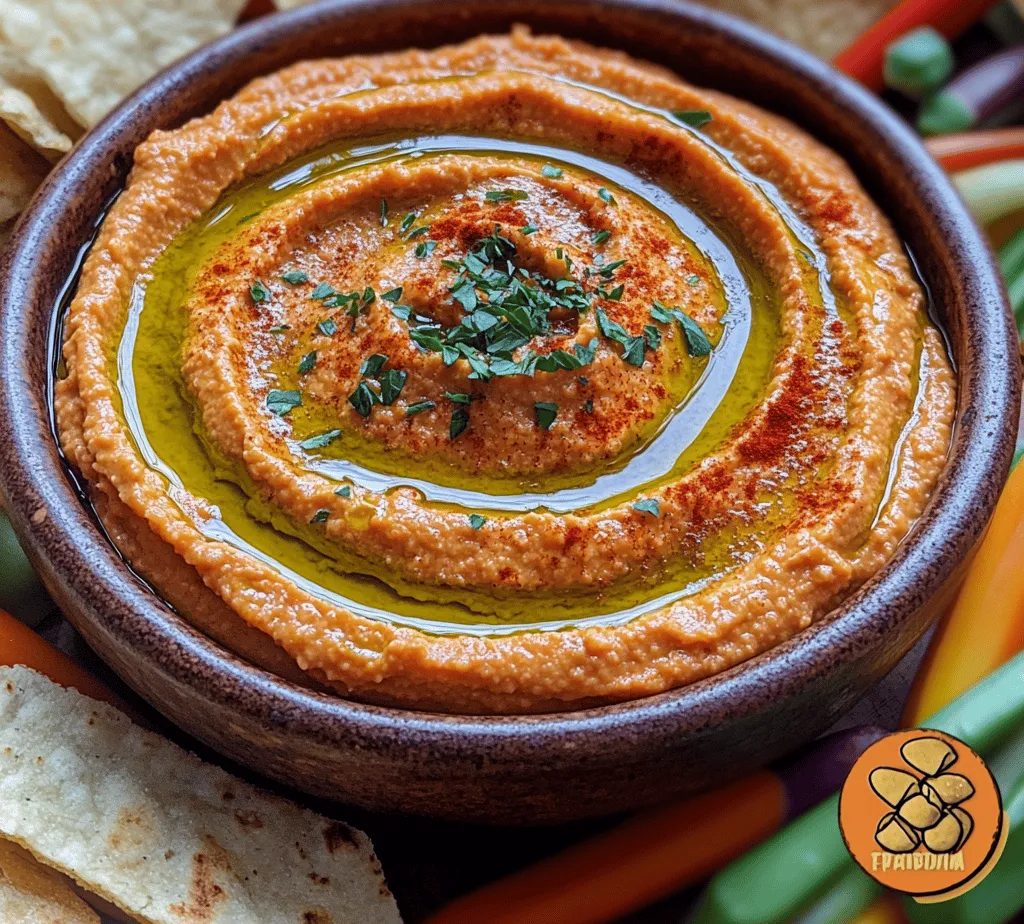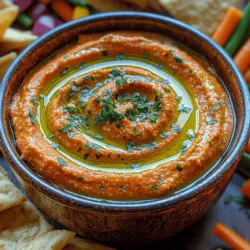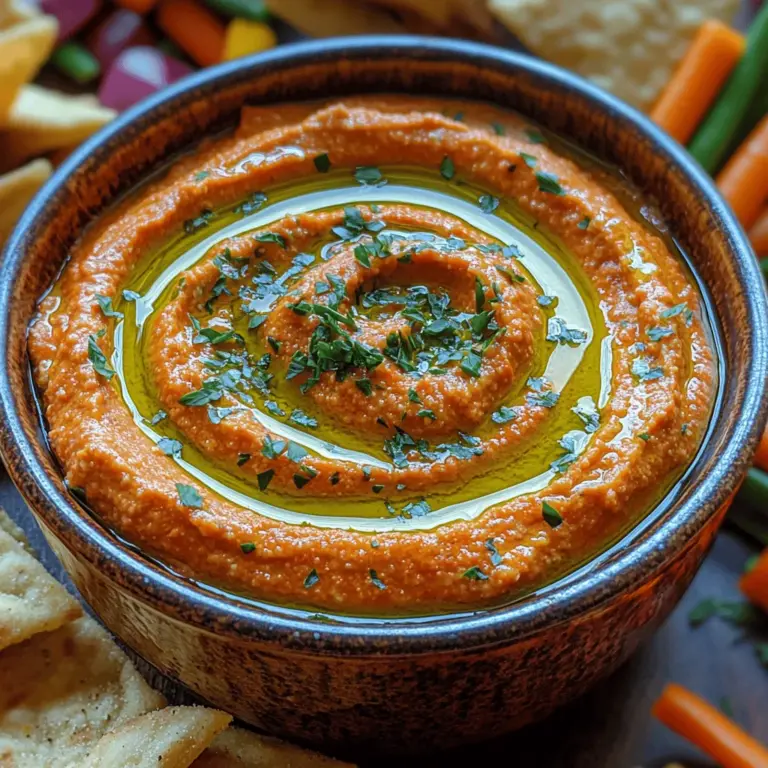Introduction
In recent years, hummus has surged in popularity, transforming from a niche Mediterranean spread into a global culinary sensation. This versatile dip has made its way onto grocery store shelves and restaurant menus alike, celebrated for its creamy texture and rich flavor. Not only is hummus delicious, but it also boasts a plethora of health benefits, making it an ideal choice for health-conscious snackers and culinary enthusiasts.
Among the many delightful variations of hummus, the Creamy Roasted Red Pepper Hummus stands out as a vibrant twist on the traditional recipe. This scrumptious dip combines the classic flavors of chickpeas and tahini with the smoky sweetness of roasted red peppers, resulting in a dish that’s both indulgent and nutritious. Perfect for parties, gatherings, or an afternoon snack, this hummus is sure to impress.
In addition to its mouthwatering taste, the ingredients in this hummus recipe are packed with nutritional value. Chickpeas, the star of this dish, are a fantastic source of plant-based protein and fiber, while roasted red peppers add a wealth of vitamins and antioxidants. Together, they create a delightful blend that is not only satisfying but also health-conscious.
Understanding Hummus
Hummus, a staple in Mediterranean and Middle Eastern cuisine, has a long and storied history. Its origins are somewhat debated, with various regions claiming to be the birthplace of this beloved dip. However, it is widely accepted that hummus dates back to ancient civilizations, with mentions in texts as far back as the 13th century. Traditionally made from blended chickpeas, tahini, olive oil, lemon juice, and garlic, hummus has evolved into a culinary canvas boasting countless variations.
Different regions have their own takes on hummus, often influenced by local ingredients and culinary traditions. For example, in Lebanon, hummus is often served with a drizzle of olive oil and a sprinkle of paprika, whereas in Israel, it might be topped with sautéed mushrooms or spiced meat. This adaptability has contributed to hummus’s worldwide acclaim, allowing chefs and home cooks alike to experiment with flavors and textures.
The nutritional profile of hummus is another reason for its widespread popularity. Packed with protein, fiber, and healthy fats, hummus is a filling and nourishing option that can be enjoyed as a dip, spread, or even a salad dressing. The chickpeas provide a hearty base, while tahini adds creaminess and a nutty flavor. Additionally, the healthy fats from olive oil promote heart health, making hummus a guilt-free indulgence.
Key Ingredients Breakdown
To create the perfect Creamy Roasted Red Pepper Hummus, understanding the key ingredients is essential. Each component plays a critical role in flavor, texture, and nutritional value.
Chickpeas
Chickpeas, also known as garbanzo beans, are the foundation of any hummus recipe. They are rich in protein, offering about 14.5 grams per cup, making them an excellent plant-based protein source. Additionally, chickpeas are high in dietary fiber, which aids digestion and promotes a feeling of fullness. They are also a good source of several key vitamins and minerals, including folate, iron, and magnesium. The creamy texture of blended chickpeas is what makes hummus so delectably smooth and spreadable.
Roasted Red Pepper
Roasted red peppers add a unique depth of flavor to hummus, introducing a sweet, smoky note that complements the earthiness of chickpeas. Beyond their taste, roasted red peppers are low in calories and high in nutrients. They are an excellent source of vitamins A and C, both of which support immune function and skin health. The process of roasting peppers enhances their natural sweetness and creates a tender texture, making them easy to blend into the hummus.
Tahini
Tahini, a paste made from ground sesame seeds, is a quintessential ingredient in traditional hummus. It not only contributes to the dip’s signature creaminess but also adds a rich, nutty flavor. Nutritionally, tahini is packed with healthy fats, particularly monounsaturated fats, which are beneficial for heart health. It also contains essential minerals such as calcium, magnesium, and phosphorus. When blended with chickpeas and other ingredients, tahini helps create a silky-smooth consistency that elevates the overall experience of the hummus.
Olive Oil
The quality of olive oil used in hummus can significantly impact its flavor and health benefits. High-quality extra virgin olive oil is packed with antioxidants and healthy monounsaturated fats. It enhances the taste of hummus while also providing anti-inflammatory properties. A drizzle of olive oil on top of the finished hummus not only adds richness but also gives the dish an appealing sheen, making it visually enticing.
Garlic
Garlic is a beloved ingredient that provides a robust flavor and is a common addition to hummus recipes. Beyond its taste, garlic is known for its numerous health benefits, including antibacterial and antiviral properties. It may also support cardiovascular health and boost the immune system. The key is to balance the amount of garlic used, as its pungency can overpower the other ingredients if not used judiciously.
Spices
Spices play a crucial role in flavor development in hummus. Cumin is a traditional spice used in many hummus recipes, lending a warm, earthy flavor that complements the chickpeas. Smoked paprika, on the other hand, introduces a depth of smokiness that pairs beautifully with roasted red peppers. The right combination of spices can elevate your hummus from ordinary to extraordinary.
Fresh Herbs
To finish off your Creamy Roasted Red Pepper Hummus, consider garnishing with fresh herbs, such as parsley or cilantro. These not only enhance the visual appeal of the dish but also add a burst of freshness and additional flavor. Fresh herbs can provide a contrast to the creamy and smoky elements of the hummus, making each bite more complex and satisfying.
Preparation of Roasted Red Peppers
Roasting your own red peppers is a straightforward process that can greatly enhance the flavor of your hummus. While you can find jarred roasted red peppers in stores, nothing compares to the taste and freshness of homemade roasts. Here’s a step-by-step guide on how to roast red peppers at home.
Step 1: Selecting the Right Peppers
When choosing red peppers, look for ones that are firm, shiny, and free of blemishes. Organic peppers are often a good option, as they are grown without synthetic pesticides and fertilizers, allowing for a cleaner flavor profile.
Step 2: Roasting the Peppers
1. Preheat your Oven: Start by preheating your oven to 450°F (232°C).
2. Prepare the Peppers: Rinse the peppers under cold water and pat them dry. Cut them in half lengthwise and remove the seeds and stems.
3. Arrange on a Baking Sheet: Place the halved peppers cut-side down on a baking sheet lined with aluminum foil or parchment paper. This will help with cleanup later.
4. Roast: Place the baking sheet in the preheated oven and roast for about 20-25 minutes, or until the skins are blistered and charred.
5. Steam and Peel: Once the peppers are roasted, remove them from the oven and transfer them to a bowl. Cover the bowl with plastic wrap or a clean kitchen towel for about 10-15 minutes. This steaming process will make it easier to peel the skin off.
6. Peel the Skins: After steaming, carefully peel off the charred skins. You can use your fingers or a paper towel to assist in this process.
7. Let Cool: Allow the roasted peppers to cool before using them in your hummus recipe.
Benefits of Roasting Your Own Peppers
Roasting your own red peppers allows for greater control over the final flavor and texture. It also ensures that your peppers are free from preservatives and additives often found in store-bought versions. Moreover, the process of roasting enhances the natural sweetness of the peppers, resulting in a richer flavor profile.
In the next section, we will delve into the step-by-step instructions for preparing your Creamy Roasted Red Pepper Hummus, combining all these delightful ingredients into a luscious dip that’s perfect for any occasion. Stay tuned for the easy-to-follow guide that will help you create this culinary masterpiece!

Detailed Instructions for Preparing the Hummus
Creating the perfect creamy roasted red pepper hummus begins with properly preparing your ingredients and employing the right techniques. Follow these steps closely to ensure a delightful texture and flavor.
Preparing the Ingredients for Optimal Blending
1. Roast the Red Peppers: Start by roasting your red peppers. You can either use a broiler or roast them over an open flame. If using a broiler, place the peppers on a baking sheet lined with aluminum foil. Broil them for about 20-30 minutes, turning every 5-7 minutes until the skin is charred and blistered. Alternatively, roast them directly on a gas flame until charred all over. Once done, place them in a bowl and cover with plastic wrap for about 15 minutes. This will help steam them, making it easier to peel off the skin. Remove the skin, stems, and seeds before adding them to the blender.
2. Prepare the Chickpeas: If you’re using canned chickpeas, drain and rinse them thoroughly under cool water to remove excess sodium and preservatives. For an even creamier texture, consider removing the skins from the chickpeas. Simply pinch each chickpea between your fingers; the skin should come off easily. This step is optional but can significantly enhance the creaminess of your hummus.
3. Gather Other Ingredients: Measure out your tahini, garlic, lemon juice, and spices. Fresh lemon juice is essential for that zesty flavor, while tahini adds creaminess and depth. Prepare your garlic by peeling and roughly chopping it. This will help it blend better and release its flavorful oils.
Techniques for Achieving the Perfect Creamy Texture
1. Blending Method: In a food processor, combine the roasted red peppers, rinsed chickpeas, tahini, garlic, lemon juice, cumin, smoked paprika, and a pinch of salt. Start blending on low speed, gradually increasing to high. Scrape down the sides of the bowl as needed to ensure everything is thoroughly mixed.
2. Add Water or Olive Oil: The key to a creamy hummus is the right consistency. As you blend, slowly add cold water or a drizzle of high-quality olive oil, one tablespoon at a time, until you reach your desired creaminess. Aim for a smooth, velvety texture that is neither too thick nor too runny.
3. Taste and Adjust: After blending, taste your hummus. This is the time to adjust flavors. If it needs more brightness, add a little more lemon juice. For additional depth, consider adding more tahini or spice. If the hummus is too thick, add more water or olive oil until you achieve the perfect consistency.
Serving Suggestions to Enhance the Dining Experience
Hummus is not just a dip; it can be the centerpiece of your meal or an elegant appetizer. Here are some serving suggestions to elevate your dining experience:
Pairing Suggestions
– Pita Chips: Homemade pita chips are a delightful and easy accompaniment to hummus. Simply cut pita bread into triangles, brush with olive oil, and season with salt and your favorite spices before baking at 400°F (200°C) until crisp. Store-bought options are also available, but homemade adds a personal touch and allows you to customize flavors.
– Veggie Sticks: Fresh, crunchy vegetables make excellent dippers. Carrot sticks, cucumber slices, bell pepper strips, and celery sticks complement the flavors of hummus beautifully. They not only add color to your presentation but also provide a wholesome, nutritious contrast.
– Other Uses for Hummus: Beyond dipping, hummus can be used as a spread on sandwiches or wraps, providing a creamy texture and rich flavor. It can also be included in grain bowls or served alongside grilled meats and roasted vegetables for a balanced meal.
The Versatility of Hummus
One of the best things about hummus is its versatility. Here are some creative ways to enjoy your roasted red pepper hummus beyond traditional serving methods:
– Incorporate into Meals: Use hummus as a base for Mediterranean wraps, layering it with grilled chicken or falafel, fresh vegetables, and greens. Spread it on toast for a quick breakfast or snack topped with avocado and seeds.
– Flavor Variations: Get creative with flavors by adding ingredients like roasted garlic, sun-dried tomatoes, or herbs such as basil or cilantro to your hummus base. Each variation offers a new taste experience.
– Vegan and Gluten-Free Considerations: Hummus is naturally vegan and gluten-free, making it an excellent option for those with dietary restrictions. You can enjoy it as part of a balanced diet without worrying about allergens.
Health Benefits of the Ingredients
The ingredients in your creamy roasted red pepper hummus are not only delicious but also packed with health benefits. Here’s a closer look at how each component contributes to your well-being:
– Chickpeas: These legumes are a fantastic source of protein and fiber, which help promote heart health and regulate digestion. Their low glycemic index can help maintain stable blood sugar levels, making them a smart choice for sustained energy.
– Olive Oil: Known for its anti-inflammatory properties, olive oil is a staple of the Mediterranean diet. It contains healthy monounsaturated fats that support heart health and may reduce the risk of chronic diseases.
– Garlic: Garlic is more than just a flavor enhancer; it’s also known for its immune-boosting properties. Rich in antioxidants, it can help combat oxidative stress and inflammation in the body.
– Spices: Cumin and smoked paprika not only add flavor but also contribute to improved metabolism and digestion. Cumin has been linked to enhanced digestive health, while paprika is rich in antioxidants and may even support weight management.
Conclusion
The creamy roasted red pepper hummus is a delightful blend of flavors and health benefits that is simple to prepare. With its luxurious texture and vibrant taste, this recipe is not just an appetizer but a versatile dish that can enhance your meals throughout the week. Whether you serve it as a dip, a spread, or a component in a larger dish, you’ll appreciate the ease and deliciousness of this homemade treat.
We encourage you to explore making this hummus at home. It’s not only a satisfying culinary experience but also a wonderful way to share healthy food with friends and family. Cooking can bring joy and connection, creating memorable moments around the table. Enjoy the process, and let the flavors inspire you to share your homemade hummus delight with everyone around you!


